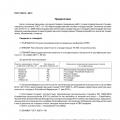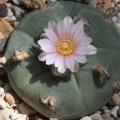How to paint wooden toys. Wood painting technique and its features. Materials for work
Archaeologists find samples of Russian wooden toys in the territories of ancient settlements and in burial grounds. Much has already been said about the fact that a toy almost always accompanied a person.
, CC BY-SA 3.0At first, these were simple dolls, often simply chopped with an ax. There are versions that many of these “koniks and pankas” served as idols, took part in rituals, and were amulets. Most likely this was the case, but there is no one to ask...
The craft of woodworking gradually improved, and toys changed and became more complex. There was a demand for them, these were no longer hastily carved “conics for my son” in a workshop, the craftsmen tried to create something new, their own, and then took them to the bazaars, where wooden toys were successfully sold.
 Guide to Russian Crafts, CC BY-SA 3.0
Guide to Russian Crafts, CC BY-SA 3.0 This was the case in Sergiev Posad, where toys were first carved by monks, and then the town near Moscow became a center for the production of wooden toys. Many now known trends in Russian wooden craft toys originated from the samples of these toys.
In the “Wooden Toys” section you can read interesting stories about the history of the origin, development, and sometimes revival of crafts, where the main skill is making toys from wood.

Elena Ivanova
If the coming year wooden horse, then we will decorate the Christmas tree with wooden toys!
This year we have already tried the decoupage technique with the children (we made hearts for mothers, everyone really liked it, we got a little used to this unusual type of creativity. Anyone who has tried to work with this technique knows how capricious a wet napkin is, wrinkles and tears easily. I’ll tell you now, how I do decoupage with preschoolers and even with children with cerebral palsy and poor hand motor skills.
Let's take wooden the workpiece and prime it for decoupage with white paint, I use acrylic (so that in case of failure, you can easily redo it).

The guys and I are doing several at once toys, because each stage requires drying, and time is precious to us).

Choose the design you like on napkins and cut it out. We remove excess layers if the napkin is 2 or 3 layers. Place the cut out picture face down on the transparent film. (for example file) and spray with water from a spray bottle.

If wrinkles form on the napkin when wet, carefully straighten it on film(it's better for an adult to do this). Lubricate the surface of the workpiece with PVA glue diluted with water. Turn over the film with the picture and place it on toy. Gently stroke through the film with your fingers from the middle to the edges, expelling air bubbles.

If the picture is crooked or a crease has formed, you can remove the film with a napkin and repeat the operation with the same picture)
Now we remove the film and be sure to coat the top of the picture with PVA glue diluted with water.
After drying decorate paint the edge using a foam sponge.

Cover with acrylic varnish.
All our toys are decorated on both sides, so they did this work for several days. Here's what we have happened:






And we also painted wooden figures.
Painting wooden toys is a traditional Russian activity. Initially, in Rus', only things necessary in life were made from wood: military instruments, a bow or a sword, musical instruments: whistles, pipes, pipes, and also dishes. Later they began to make children's toys in the form of horses, birds, dolls, and nesting dolls. The production centers were Gorodets, Semenov, Lyskovo, Purekh, Fedoseevo.Description
Painting wooden toys is a traditional Russian activity. Initially, in Rus', only things necessary in life were made from wood: military instruments, a bow or a sword, musical instruments: whistles, pipes, pipes, and also dishes. Later they began to make children's toys in the form of horses, birds, dolls, and nesting dolls. The production centers were Gorodets, Semenov, Lyskovo, Purekh, Fedoseevo.
In the theoretical part, the master will tell in detail the history of Russian wooden toys. It will also show the types of painting and their features. After all, wooden toys can be painted, decorated with patterns using stencils, or decorated using the decoupage technique.
In the practical part, participants will go through all the stages of preparing and painting a wooden toy. As a result, everyone will receive a bright toy that can be kept as a keepsake or given to a friend. After the master class, everyone will have a file with complete instructions for painting a wooden toy, personal skills and abilities. Perhaps one of the participants will enjoy this activity and acquire a new hobby, which may develop into a vocation. After all, handmade toys will always be in fashion!
4311 (33 per week) / 03/04/16 10:00 /
These dolls came to us from Germany and for a long time were considered the lot of the poor who do not have enough money for normal toys. However, today blanks for peg dolls are very popular, since allow you to create very interesting designer toys for children with your own hands, and this master class is dedicated to working with these blanks and creating unique dolls.
Materials for work:
- Wooden blanks for Peg dolls;
- Palette for mixing shades;
- Acrylic paints of various colors (it doesn’t matter whether they are in tubes or jars);
- Waterproof varnish (you can use acrylic or parquet, but not oil-based, but water-based varnish is the safest);
- Sandpaper (just in case);
- Simple pencil;
- Soft brushes of different sizes;
- PVA glue;
- Plain water;
As a rule, the surface of wooden blanks is already polished without any chips or cracks, but you it is worth carefully inspecting the future toy, to identify flaws in advance, if any. Small cracks, chips or unevenness can be eliminated using regular sandpaper. We simply sand the surface first with coarse sandpaper, then with finer sandpaper until the surface becomes more uniform and smooth.

When the workpiece is perfect, you need to prepare a solution of PVA glue. To do this, mix it with ordinary water in proportions 3 to 1. This will protect the wood and prevent the paint from further absorbing into the material and spreading during the painting process.
We cover the workpiece with this solution at least three times, allowing each layer to dry completely. It will take a lot of time, but the result will be worth the effort.
By the way, instead of PVA solution, you can also use starch jelly. In this case, the consistency of the finished substance should be quite thick, but without lumps. Also, 2-3 layers are enough so that the paint does not begin to penetrate into the wood structure.


After the third layer has dried, we begin to draw the doll’s face. We have several examples of how to paint a doll's face. The main thing is that the initial sketch is made using an ordinary simple pencil (preferably soft, so that when drawing lines it does not scratch the layer of dried base), and if you don’t like something, all this can be easily removed using a regular eraser.

And now, after the final touch of your sketch, the fun begins - we begin to paint using brushes of different sizes. It is very convenient to use a palette for working with paints, which can be an ordinary plastic cutting board, cells for eggs or candies, as well as small plastic lids. In such containers, the paint will not spread, and on a plastic board you can mix different colors with each other to get the desired shades that are not in the package.
Many parents have found themselves in a situation where their tired child begins to act up, throw things, fight, and is about to become hysterical. Ta...
You need to paint starting with the largest elements, smoothly moving to smaller details. The final touch is the application of a dark outline, which will separate the colors and details from each other, and also hide some flaws that will definitely be made when painting.
Be sure to let the paint dry, and to avoid trouble, it is better to leave it alone for at least a day.
After this, the toy can be coated with the chosen varnish and left to dry for another day to finally make sure that the toy is ready for testing in children's hands.
Wood painting is considered one of the oldest types of creativity and drawing. This method of decoration was widespread in Rus'; wooden boards were painted, panels, trays and boxes were decorated with paints. To learn how to decorate wooden objects yourself, you just need to learn the basic painting techniques.
This type of decorative and applied art has been passed down from generation to generation. Adults and children depicted original patterns based on folk motifs, which were later framed. Decorating with the help of painting various interior items was considered popular. In this form, this art has survived to this day, when furniture, dishes, toys, and musical instruments are decorated with decorative painting on wood.

Craftsmen use coloring compounds for various purposes as materials for their work. You can paint on wood with gouache, acrylic, watercolor and even oil.
Making your own beautiful painted board for cutting food is not difficult even for a child: the whole process consists of selecting a design, transferring it to the surface, and gradually decorating it. It is important to achieve the right combination of colors so that the boards look harmonious.
- Khokhloma - characterized by a black background, as well as yellow and red colors, where fancy flowers are depicted.

- – the main motifs are drawings dedicated to urban scenes, epics and flower arrangements.

- - a type of painting on wood, the main subjects of which are ornaments and horses.

To learn how to paint on wood, you need to familiarize yourself with the basic techniques, which you can learn about in the following sections.
How to paint a kitchen board with acrylic paints?
The most convenient material for getting acquainted with folk art and mastering technology is acrylic paints. They are thick enough and can be mixed to achieve a spectacular image. After painting a wooden board with such paints, it is not necessary to varnish the surface, because acrylic creates a durable protective film.
To work you will need:
- kitchen cutting board with a smooth surface;
- specified paints of the required colors;
- tassels;
- stencils for painting.
Choose high-quality artistic acrylic paints that have sufficient thickness - this is how the drawing will be rich.

The surface of the board must be flat; if there are protrusions on it, it is recommended to use sandpaper and sand the surface of the wood. After this, the masters recommend saturating the base with white acrylic so that subsequent sketches will lie flat on the board. While the workpiece is drying, you need to transfer the design onto wood, you can find out how to do this in the last section of this material.
The peculiarity of the products obtained after painting is that they have a bright and rich color. You need to start painting the board with large elements of the design, gradually moving on to smaller details. To highlight individual details of the image, paint them with a thin brush in black or white.

After painting on wood with acrylic paints, the product must be thoroughly dried. The next step will be varnishing the board if the product is intended to be used for its intended purpose. If the finished result will serve only a decorative function, then there is no need to varnish the board - painting with acrylic paints will stick to the wood on its own.
In the video: painting a cutting board with acrylic paints.
Painting wood with watercolors and its features
The technology of painting wooden bases with watercolors involves quickly applying paint to the surface. Some argue that watercolor is completely unsuitable for such coatings, because excessive wetting of the wood leads to its damage. You can correct the situation and learn how to properly paint on wood with watercolors - you just need to choose the right technique.
For beginners, painting with watercolors should not be a complicated procedure; you can practice on wooden blanks in the form of nesting dolls. After transferring the drawing, you need to brush it once with a wet brush over the area of the workpiece that needs to be painted. This is done for better paint adhesion. Step by step, large areas are first painted, and then colors are added to the details.

The use of watercolor on wood has a number of features:
- the ability to create light and airy images, equipping them with shadows and color transitions;
- lack of relief of the stroke, which cannot be said about painting wooden bases with acrylic or oil paints;
- a face painted on wood in watercolor most accurately conveys the shades truthfully;
- the ability to mix watercolors with other types of paints for painting on wood.
The finished product can be coated with clear varnish. Watercolors are also used to decorate backgrounds on panels, because this paint is a pigment diluted with water, which is most optimal for large areas.
Gouache for painting as an alternative
A cutting board for the kitchen is one of the practical items of regular use. To make this accessory pleasing to the eye every day, it is recommended to paint it; this can be done with gouache paints on wood. This coloring material is similar to acrylic, but is a little less rich in saturation.

Painting on wood with gouache consists of the following stages:
- Sanding the board.
- If the surface of the product was not smooth enough, it must be polished with sandpaper. Structure protection.
- If the board does not have a varnish coating, it must be treated with stain.
- Priming. For this, acrylic of any suitable color is used. The wooden board should be carefully coated with paint without gaps. This will make coloring easy and quick.
- Varnishing.
After finishing the process, it is recommended to open the product with varnish. You can use any composition that you have at home, but odorless acrylic varnish is considered the most suitable.

The master class presented in the photo below is designed for people who do not have the skills to paint kitchen boards. Painting on wood brings pleasure, and the resulting result delights everyone around you.

It is necessary to apply varnish to the finished product in several layers, but after the previous layer has completely dried. The kitchen is a place where moisture is constantly exposed, so this stage is considered mandatory.
Methods for transferring a drawing onto a base
- Some fans of painting on wood only with experience begin to draw pictures on wood on their own. Beginners cannot do this, so the question arises, what are the ways to transfer a picture onto a wooden base? You can find out more about them below:

- Carbon copy.

- This method is considered the simplest - it requires regular dark or (in the case of a black base) white carbon paper. The printed sheet is placed on a carbon copy, under which a wooden blank is placed. Using a pen, the drawing is completely outlined. As a result, an image is formed on the workpiece that can be painted. The resulting painted product is neat.
Tracing paper.
To make the painting have beautiful borders, you can use tracing paper. To do this, it is applied to the prepared drawing and traced along its contours. Next, the sheet is turned over and rubbed generously with graphite. After this, tracing paper is placed on the tree and the image is traced with a sharp object. Using this method it is possible to draw even the most complex patterns.
Soap. The method is similar to the previous one, but it is good when the templates for painting are transferred to a black surface. It is necessary to repeat the same operations, only rub the tracing paper not with graphite, but with soap.
































 Master classes on painting wood (2 videos)
Master classes on painting wood (2 videos) Various options and ideas (30 photos)
Various options and ideas (30 photos) Did not find an answer to your question? Look at here
Did not find an answer to your question? Look at here